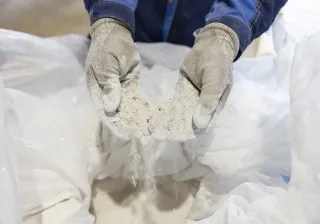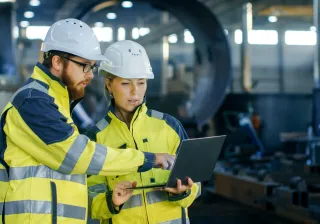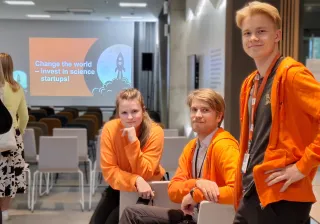At VTT, we work hard to support companies that are committed to driving the transition toward more sustainable industry. We rarely shy away from challenges and develop technological solutions for demanding use cases, such as replacing combustion-based industrial processes with low-carbon alternatives. Our electric rotary kiln provides a flexible and efficient low-emissions alternative to traditional, CO2-heavy processes used in lime and cement production – and may give your company a competitive edge.
Moving away from emissions-heavy processes is a must
Successful climate change mitigation will remain a distant goal unless new, sustainable solutions become available and widely adopted in heavy industries. For a long time, finding alternative, low-emissions solutions have seemed nearly impossible – or at least extremely costly – for many industries. However, we can now see that moving away from traditional fossil-heavy methods, such as combustion-based calcination is not only a theoretical possibility, but an available alternative for industries such as cement, and pulp.
While the decarbonisation of industrial processes is no small feat and will require continued commitment from companies and researchers alike, it is hard to argue against the increasing pressure and growing value of moving away from fossil-based solutions. With the current developments, sustainability and ability to adapt will increasingly determine the future success of companies and entire industries.
A big part of the process is the increasing electrification of industry. With the accelerating energy transition, we are witnessing the availability of renewable energy increase quickly – for example in Finland, the country’s wind power capacity grew by 75 % during 2022 alone. Despite recent uncertainties in the European energy market, the long-term trend supports the huge potential of electricity as a key component of industrial decarbonisation.
Gain a competitive edge with electric calcination
The costs of emissions trading are the central regulatory mechanism driving the decarbonisation of European industry. At the same time, emissions trading plays a key role in determining the long-term value and viability of investments into new, alternative technologies.
The only pressure does not, however; come from the cost structure and regulation alone. Increasingly, customers at different points of the supply chain are tightening their requirements for the environmental footprint of the materials they source. In the future, these customer demands are likely to play an even bigger role in pulling forward the efforts to move away from the current calcination technology where both the decomposition reaction and burning fossil fuels to heat the reaction generate CO2 emissions.
VTT’s electric rotary kiln is a prime example of a revolutionary step forward in an industry, where sustainable solutions haven’t been previously available. Our electric kiln can replace fossil-fuel based solutions for calcination while allowing energy-efficient CO2 capture in the process. This can significantly reduce the carbon footprint of industries such as the cement industry that are responsible for some of the highest carbon emissions levels globally.
During 2021 and 2022 we at VTT have successfully worked with industry partners to demonstrate through several experiments with different feedstocks the commercial applicability of our electrically heated rotary kiln. To continue the work, we are now looking for major industrial players to partner with us to keep developing optimal solutions for different industry applications. In addition to our existing electric rotary kiln, we have profound knowledge on fluidised bed technologies based on experimental research with our pilot scale fluidised bed reactor and we are now working on electrifying the technology as well. We work closely with industry partners as well as the global research community to solve a range of demanding industry-specific problems with commercially viable and environmentally sustainable technologies.
Explore new opportunities from rapidly developing technologies
We view the accelerating decarbonisation and electrification as a much-needed and largely unavoidable next step for most industries. But at the same time, we also see it as an opportunity to explore new business models and revenue streams. For example, our electrically heated rotary kiln allows capturing CO2 in the calcination process, and the captured CO2 in turn has its own market and can be used for industrial purposes from synthetic fuels to novel materials, like plastic replacements, or mixed into the concrete to be used in construction. We also help our customers identify potential uses for different industrial side streams.
In the future, we foresee that the changing electricity market may create new opportunities for industry players that arise from Demand Side Response (DSR) and Frequency Containment Reserves (FCR). Flexibility and adjustability become increasingly important in the electricity grid with the increase of renewable energy, which naturally fluctuates in supply. This means, that the need for balancing resources in the electricity market will similarly become more valuable. Therefore, if an industrial process, such as calcination with an electric rotary kiln, allows even relatively small adjustability, its balancing capacity can potentially be sold to the grid operator for DSR or FCR services.
Want to hear more? We are eager to work with industry partners to discover new technologies and business opportunities! Our broad know-how and long experience in industrial process development allows us to support companies in exploring alternative ways to either develop or replace their existing processes with more sustainable technologies. Get in touch with us!
Our experts








